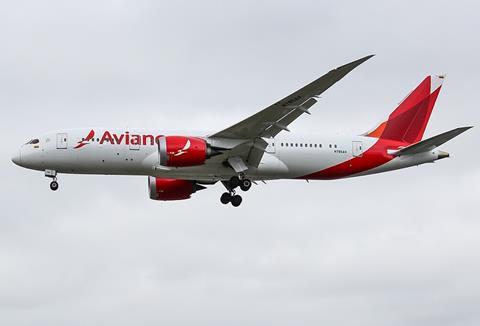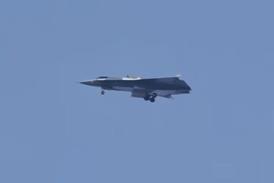Investigators analysing a depressurisation incident involving a transatlantic Avianca Boeing 787-8 have disclosed that an air-conditioning system was misassembled during maintenance work a few days before.
Avianca’s AV46 service from Bogota to Madrid Barajas on 31 October last year was the third flight for the twinjet (N785AV) since this maintenance work, involving both air-conditioning packs, was carried out over 2-27 October.
Portuguese investigation authority GPIAAF says the aircraft had been cruising at 42,000ft when the crew received a generator-drive alert for the left-hand Rolls-Royce Trent 1000 engine. With the cabin altitude at 6,100ft the crew opted to execute a rapid descent.
The aircraft descended to below 22,900ft – with the cabin altitude increasing to 10,100ft – when the crew switched off the left pack.
But GPIAAF says the cabin altitude increased further to 11,370ft, and a cockpit warning was triggered, prompting the crew to don oxygen masks and conduct an emergency descent to 10,000ft.
The crew also manually deployed the passengers’ oxygen masks, even though the cabin altitude did not exceed 14,000ft.
After declaring an emergency, the pilots diverted to Ponta Delgada in the Azores where the 787 landed without further incident. None of the 259 occupants was injured.

Flight-data recorder information showed both cabin air compressors stopped operating, due to overload, after the failure of one of the two left-hand variable-frequency starter generators.
While the operational right-hand pack should have been sufficient to maintain cabin air pressure after the left-hand pack failure, inspection of the aircraft showed the right-hand pack “was also experiencing problems”, says GPIAAF.
On a previous flight, the carrier learned, the cabin temperature had been difficult to control.
GPIAAF says the extensive maintenance work recently completed on the aircraft’s packs specifically involved the recirculation fans.
“This work resulted in a misassembled recirculation duct, allowing a gap to occur which consequently resulted in a significant leak,” it states.
Maintenance personnel told investigators that the right-hand pack area is difficult to access, with little space for handling components and tools.
According to GPIAAF, Avianca has said it is working on the issues highlighted with the maintenance provider. GPIAAF adds that the failed generator has been sent to its manufacturer for analysis.


























